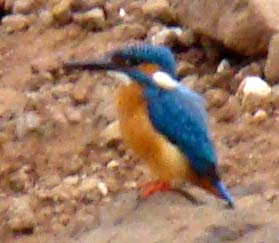The barbets are called so because they have bristles
growing around their thick beaks (Latin barba, beard).
Brown-Headed Barbet
Megalaima zeylanica
27 cm
Male/female alike
Characteristics: Brown head and breast finely streaked,
brown throat, orangish circumorbital (around the eye) skin and bill (when
breeding), white spotted wing coverts. Streaking is almost absent on belly and
flanks. They are a little clownish to look at with their plump bodies and big
heads on a short stocky neck and thick, red bill.They have an unmistakeable
loud call. Raka’s next door neighbour Mrs D’Costa (an ardent animal/bird lover,
God bless her soul) in Lucknow used to call the bird “Batao” (meaning “say” in
Hindi) because that is how he sounds.
Distribution: Widespread resident but their colourings
and their penchant for densely leaved high trees, makes them difficult to take
a picture of, even though you can hear their loud call resonating from every
tree. You can imagine my delight when after chasing them in all the beautiful old
ficus trees in the Lucknow Residency I found this one nesting hardly at a
height of 7-8 feet and boldly looking at me too!
In Maharashtra I’m more likely to see the white-cheeked
barbet, which is more common in the Western Ghats. Still waiting to click one.
Diet: Eats fruits, berries and insects.
Breeding: The Barbets in Raka’s garden would nest in
the same hole, dug by the birds themselves like a woodpecker, in the small 'Harsingar' tree every year till she chopped of the tree :-{ (unbelievable!!). They
lay 2-4 eggs, both parents take turns to incubate.
Coppersmith Barbet
Megalaima haemacephala
17cm
Male/female alike
Characteristics: This adorable little bird with a crimson
forehead and breast patch, yellow patches above and below the eye, yellow
throat and streaked underparts, would be quite conspicuous if it were’nt so
little. The Juvenile does not have the red on head and breast. Has a repetitive
tuk tuk tuk call which sounds like the hammering of a metal-smith hence the
name.
Distribution: Widespread resident and can be seen in
open wooded country and groves. I have regular visitors on the Gulmohar tree
outside my Living room window. You must see Rajeev’s video of a couple of them
fighting like kids to sit inside a tree hole where they roost on a hot day even
when not nesting.
Diet: Fruits, berries and figs, eating them whole and
helping in seed dispersal. Sometimes they will eat insects like termites.
Breeding: They dig out holes in trees to make their
nests like the other barbets. They breed practically the year round with some
local variations. 3-4 eggs are laid at a time and incubated by both parents.
Blue Throated Barbet
Megalaima asiatica
23cm
Male/female alike
Characteristics: Blue ‘face’ and throat, red forehead
and the back of the crown and a black band across crown. Juveline has duller
colors. Call is a loud took-a-took.
Distribution: It is a resident bird of the Himalayan
region but may be seen across the sub continent. I saw it in Himachal Pradesh
in a small place called Jia.
Diet: Consists of fruits and insects.












































